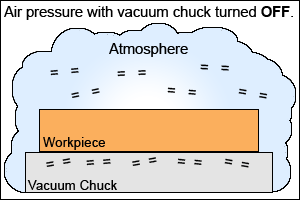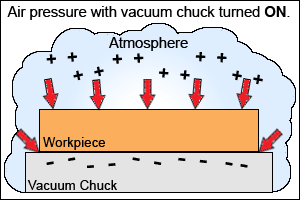Despite the common explanation that vacuum chucks operate by sucking parts down, the truth is quite the opposite. Vacuum chucks rely on the atmospheric air pressure around them to push parts onto their surface.
 Atmospheric air pressure exists around 30″ Hg or 15 PSI at sea level (Yes, every square inch of our bodies has 15 lbs of air constantly pressing on us). This is why passengers on planes flying at high altitudes can experience swelling due to lower pressures in the cabin. Cabins are typically pressurized to an equivalent of being at 8,000 ft above sea level. At this altitude there is roughly 11 PSI of air pressure. Translate this into workholding and users at higher altitudes will experience a significant drop in holding force equating to a loss of 0.5 PSI per 1,000 ft above sea level. A high powered vacuum pump operating in outer space would be completely ineffective.
Atmospheric air pressure exists around 30″ Hg or 15 PSI at sea level (Yes, every square inch of our bodies has 15 lbs of air constantly pressing on us). This is why passengers on planes flying at high altitudes can experience swelling due to lower pressures in the cabin. Cabins are typically pressurized to an equivalent of being at 8,000 ft above sea level. At this altitude there is roughly 11 PSI of air pressure. Translate this into workholding and users at higher altitudes will experience a significant drop in holding force equating to a loss of 0.5 PSI per 1,000 ft above sea level. A high powered vacuum pump operating in outer space would be completely ineffective.
 The atmosphere likes to remain at a constant level and it is this principle that causes the wind to blow – air flows from high pressure to low pressure. When objects are tossed around by the wind, they are acting as obstacles to this high-pressure-to-low-pressure flow. When a vacuum chuck is turned on the air pressure decreases below the workpiece which causes higher air pressure above the workpiece to want to fill this low pressure space below it. The workpiece becomes an obstacle which is pressed against the chuck.
The atmosphere likes to remain at a constant level and it is this principle that causes the wind to blow – air flows from high pressure to low pressure. When objects are tossed around by the wind, they are acting as obstacles to this high-pressure-to-low-pressure flow. When a vacuum chuck is turned on the air pressure decreases below the workpiece which causes higher air pressure above the workpiece to want to fill this low pressure space below it. The workpiece becomes an obstacle which is pressed against the chuck.
The next time someone tells you that a vacuum chuck sucks parts down ask them when was the last time they saw the wind suck over a tree!

 Atmospheric air pressure exists around 30″ Hg or 15 PSI at sea level (Yes, every square inch of our bodies has 15 lbs of air constantly pressing on us). This is why passengers on planes flying at high altitudes can experience swelling due to lower pressures in the cabin. Cabins are typically pressurized to an equivalent of being at 8,000 ft above sea level. At this altitude there is roughly 11 PSI of air pressure. Translate this into workholding and users at higher altitudes will experience a significant drop in holding force equating to a loss of 0.5 PSI per 1,000 ft above sea level. A high powered vacuum pump operating in outer space would be completely ineffective.
Atmospheric air pressure exists around 30″ Hg or 15 PSI at sea level (Yes, every square inch of our bodies has 15 lbs of air constantly pressing on us). This is why passengers on planes flying at high altitudes can experience swelling due to lower pressures in the cabin. Cabins are typically pressurized to an equivalent of being at 8,000 ft above sea level. At this altitude there is roughly 11 PSI of air pressure. Translate this into workholding and users at higher altitudes will experience a significant drop in holding force equating to a loss of 0.5 PSI per 1,000 ft above sea level. A high powered vacuum pump operating in outer space would be completely ineffective. The atmosphere likes to remain at a constant level and it is this principle that causes the wind to blow – air flows from high pressure to low pressure. When objects are tossed around by the wind, they are acting as obstacles to this high-pressure-to-low-pressure flow. When a vacuum chuck is turned on the air pressure decreases below the workpiece which causes higher air pressure above the workpiece to want to fill this low pressure space below it. The workpiece becomes an obstacle which is pressed against the chuck.
The atmosphere likes to remain at a constant level and it is this principle that causes the wind to blow – air flows from high pressure to low pressure. When objects are tossed around by the wind, they are acting as obstacles to this high-pressure-to-low-pressure flow. When a vacuum chuck is turned on the air pressure decreases below the workpiece which causes higher air pressure above the workpiece to want to fill this low pressure space below it. The workpiece becomes an obstacle which is pressed against the chuck.